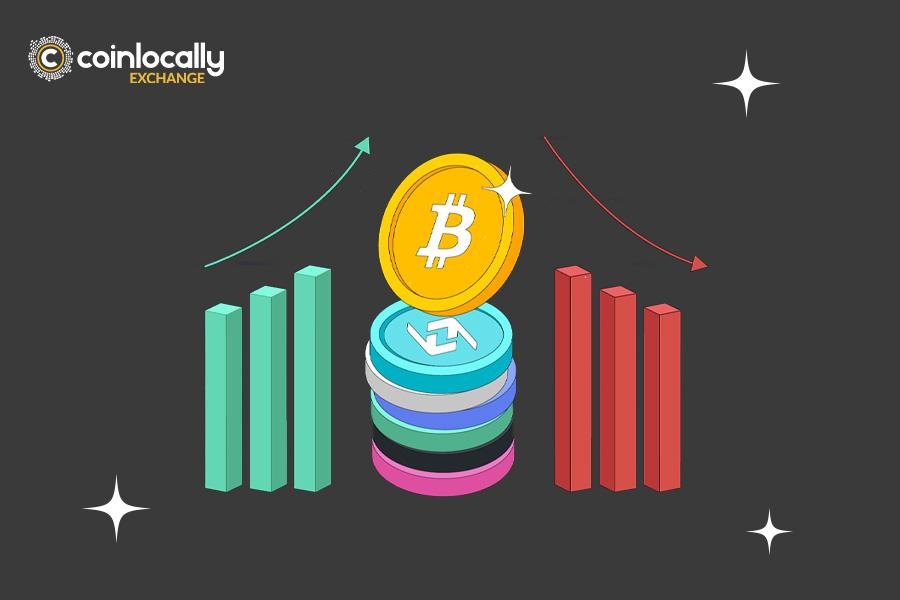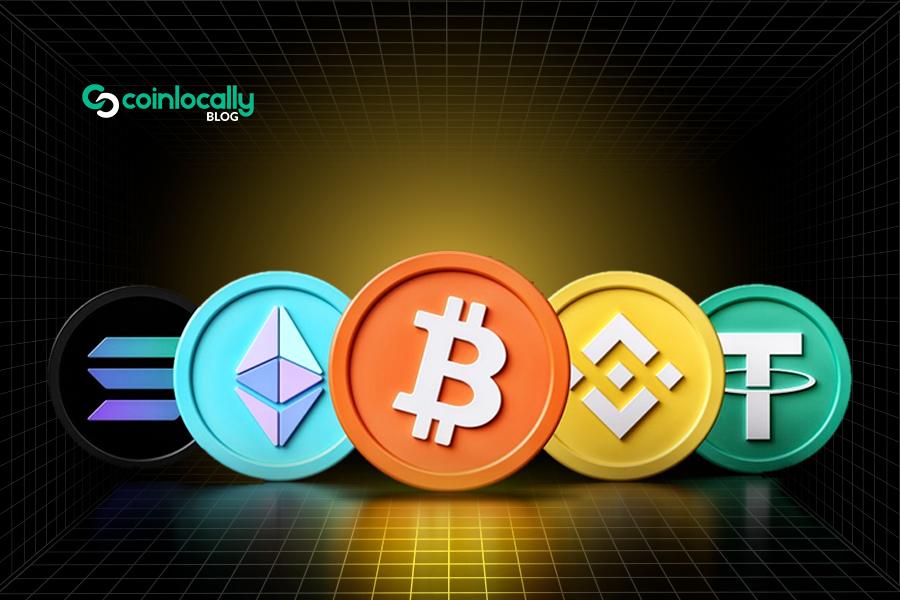Crypto gurus look for more scarcity and higher value in crypto assets. The ten best deflationary cryptocurrencies we’ll explore provide these features, making them lucrative investment options. Keep scrolling to learn about deflationary crypto, how it differs from inflationary coins, and the best deflationary coins.
Table of Contents
What Does a Deflationary Cryptocurrency Mean?
A deflationary coin is a cryptocurrency that becomes more valuable over time as its circulating supply decreases.
Deflationary coins permanently remove a part of their circulating supply from circulation using a burning mechanism.
In simple terms, token burning occurs when the development team sends certain coins to a wallet address that no one can access. By sending the tokens to that address, the tokens go out of circulation.
Scarcity increases a cryptocurrency’s value. Burning decreases the coin’s total supply, meaning that the remaining coins are scarcer and, therefore, have a higher value.
This mechanism motivates users to hold their coins for a longer time as their value increases over time.
In addition to the deflationary coins explained above, some tokens are hyper-deflationary; let’s see what they are and how they differ from deflationary ones.
What is a Hyper-Deflationary Token?
Hyper-deflationary tokens have an extreme deflation rate, i.e., their circulating supply decreases swiftly over time. They use various mechanisms, such as token burning, redistribution, and liquidity locking.
As mentioned above, in token burning, some of the coins are sent to an unspendable address, i.e., these tokens go out of circulation forever, and the remaining ones go up in scarcity and value.
In a redistribution mechanism, the system redistributes a small percentage of each transaction to current token holders. This incentivizes them to hold their tokens longer, as they will earn more tokens over time.
Hyper-deflationary tokens use the liquidity locking mechanism to lock some of the token’s liquidity in a smart contract, stopping its trading, increasing its scarcity, and boosting its value.
All in all, hyper-deflationary tokens are considered high-risk, high-reward investments. But does it mean inflationary tokens are not good? To answer this question, we need to learn what inflationary cryptocurrencies are.
What is Inflationary Crypto?
Unlike deflationary coins, inflationary crypto refers to cryptocurrency that increases circulating supply over time. Inflationary coins increase supply through the minting mechanism, which creates new tokens at a predetermined rate.
The most famous example of an inflationary cryptocurrency is Ethereum, which has an annual inflation rate of about 4-5%. This means that Ethereum’s supply goes up by 4-5% each year, which can result in its value dilution over time.
Inflationary cryptocurrencies operate like traditional fiat currencies, where the supply can be increased over time. While this might seem counterintuitive in crypto, it’s not inherently harmful.
Supporters of inflationary cryptocurrencies claim that an increase in supply can boost the stability of the currency’s value, making it a better option for everyday transactions.
However, critics of inflationary cryptocurrencies argue that constant minting can lead to decreased value and potentially even hyperinflation.
Also, keeping inflationary cryptocurrencies for a long time is not lucrative since their value is likely to decrease over time.
If you still have questions about deflationary and inflationary cryptocurrencies, keep reading.
Deflationary Cryptocurrency vs. Inflationary Cryptocurrency
Their supply management system over time makes deflationary and inflationary cryptocurrencies different.
Deflationary cryptocurrencies become scarcer over time through mechanisms like token burning, which can increase their value.
In contrast, inflationary cryptocurrencies become more abundant due to the minting or mining of new coins, potentially decreasing their value.
The following table depicts the main differences between deflationary and inflationary cryptocurrencies.
Considering the above differences, can we say deflationary coins are good? The following section will tell us.
Are Deflationary Cryptocurrencies Good?
The answer to the question of whether deflationary coins are good or not depends on your specific preferences, priorities, and goals.
The main advantage of deflationary coins is that their supply decreases over time, meaning that they become scarcer and more valuable. This is especially attractive for long-term investors.
Deflationary coins cannot be the first option for all investors, given that their price is prone to extreme volatility. They can also be subject to extreme price volatility and are unsuitable for daily transactions.
Also, market demand, competition, and regulatory issues affect deflationary coins’ value.
Furthermore, some argue that because of extreme scarcity, the deflationary coin is not an ideal currency or a means of exchange, as its value can be too high for daily transactions. Overall, deciding if deflationary coins are good depends on your priorities, goals, risk tolerance, and investment strategy.
If you invest in deflationary coins, keep scrolling to learn about the ten best crypto coins.
The Best Deflationary Cryptocurrency Coins
Here are the best deflationary crypto coins, and we’ll elaborate on each in the following subsections.
- Bitcoin (BTC)
- Ethereum (ETH)
- Binance Coin (BNB)
- Chainlink (LINK)
- SafeMoon (SAFEMOON)
- Stellar (XLM)
- Basic Attention Token (BAT)
- Polygon (MATIC)
- Tezos (XTZ)
- Cardano (ADA)
Bitcoin (BTC)
The first and most famous cryptocurrency, Bitcoin, comes with a limited supply of 21 million coins and uses a Proof-of-Work (PoW) consensus mechanism.
Bitcoin’s value is highly volatile and is affected by many market factors, but it is widely accepted and supported by a vast community.
Bitcoin undergoes a halving event approximately every four years, which cuts the mining reward in half. This process helps reduce inflation and establishes a deflationary system.
Ethereum (ETH)
Ethereum is the second-largest cryptocurrency by market capitalization, with a circulating supply of over 115 million coins.
Moreover, Ethereum follows a fee-burning mechanism to keep ETH deflationary. This new fee-burning mechanism (previously known as EIP-1559) changes the method of calculating transaction fees (aka Ethereum gas fee).
Ethereum started burning (removing ETH from circulation) a portion of every transaction fee to decelerate the rate of issuing new ETHs.
In other words, every new transaction on the Ethereum blockchain reduces the total supply of ETH coins.
The rest of the coins follow the usual supply and demand routine. If supply decreases over time following this new burning mechanism, the price of Ethereum can increase, which is good news for investors.
This new burning mechanism has been made available thanks to Ethereum’s upgrade to the PoS consensus algorithm.
Deflationary Cryptocurrency: Binance Coin (BNB)
Binance Coin, the native token of the Binance exchange, is used for discounted trading fees and other platform features. Its limited supply is 170 million coins, and it has a regular burning mechanism to decrease supply and increase value.
As part of the BNB coin burning mechanism, a portion of the Binance exchange’s profits is used to buy back and destroy BNB tokens.
It happens every quarter to about 20% of the profit until 100 million BNB tokens are burned, i.e., the maximum supply of BNB.
The Binance exchange’s total trading volume in the last quarter determines how many BNB tokens need to be burned in the next quarter. coins, a part of which is used for staking and network fees.
In other words, Chainlink uses a staking mechanism to incentivize holders to keep the tokens longer instead of burning the LINK tokens to decrease the supply and increase the tokens’ value.
Although Chainlink does not have a common burning mechanism, its staking mechanism aims to decrease the number of LINK tokens available and increase demand for the remaining tokens.
Chainlink team believes that this decision can raise the price of the LINK token over time and encourage the long-term holding of its tokens.
SafeMoon (SAFEMOON)
SafeMoon is another deflationary coin that has become popular due to its unique tokenomics. These include a 10% transaction fee that is divided between token holders and liquidity providers.
SafeMoon uses two methods, i.e., token burning and redistribution mechanisms, to reduce the supply decrease over time.
Safemoon cuts a percentage of each transaction fee and burns it permanently using a smart contract programmed to deduct a 10% fee on every transaction of the Safemoon platform.
The reduced 10% is cut in half. 5% goes to existing Safemoon holders to incentivize them to hold the tokens longer. 2.5% of the second half is used in the liquidity pool, and the rest is burned.
Although Safemoon uses this method for good reasons, some argue it won’t be a successful plan in the long term.
Stellar (XLM)
Another decentralized platform specializing in cross-border payments and asset transfers is Stellar, whose value is influenced by adoption and market demand.
Stellar’s supply increases at a fixed rate of 1% per year, but this rate can be changed based on community consensus.
Like Ethereum, Stellar follows a fee-burning method to decrease the supply of its native token XLM.
The Stellar platform collects fees from each transaction and adds them to a fee pool, where they accumulate over time. The platform also burns some of these fees by sending them to an address with unknown private keys, which helps reduce the overall supply over time.
The size of the fee polo determines the number of XLM tokens that must be burned.
Deflationary Cryptocurrency: Basic Attention Token (BAT)
Brave Browser has released Basic Attention Token as its native cryptocurrency, which aims to provide a more privacy-focused and ad-free browsing experience.
BAT rewards and incentivizes users in the Brave ecosystem. It has a limited supply of 1.5 billion coins.
The BAT burning mechanism occurs in four steps as follows:
- Advertisers pay BAT tokens to buy ad space.
- Users willing to watch these ads are rewarded with a portion of the BAT tokens paid by the advertisers.
- The rest of the BAT tokens paid by advertisers are sent to the user growth pool, which is managed by the BAT development team.
- Some of these tokens sent to the pool are burned periodically, i.e., sent to an Ethereum address with an unknown private key.
Polygon (MATIC)
Polygon is a layer-2 scaling solution for Ethereum designed to improve scalability and minimize transaction costs.
Adoption and usage are two critical factors affecting Polygon’s value. Its supply is managed to go up at a fixed rate of 13.9% per year.
Polygon network transaction fees are sent to a burn address with an unknown private key to go out of circulation.
Transaction volume and the current price of MATIC tokens primarily determine how many tokens will be burned, which helps reduce supply and increases their value over time.
Deflationary Cryptocurrency: Tezos (XTZ)
Tezos is a self-amending blockchain platform that enables decentralized governance and smart contract functionality.
The adoption of Tezos and market demand drive its value, while its supply will increase at a fixed rate of 5.5% each year.
Tezos’s method of validating transactions and securing the network is called baking. Bakers hold the XTZ tokens and lock them up for collateral, which is how they validate transactions and add new blocks.
In addition, Bakers who successfully validate a block receive Tezos tokens and a portion of transaction fees as rewards.
Bakers need to burn some of this reward by sending a portion of it to a burn address.
Tezos determines how many tokens to burn based on transaction volume and the current price of XTZ tokens.
Cardano (ADA)
Prioritizing security and sustainability, Cardano is a decentralized blockchain platform for developing Decentralized Applications (dApps).
Adoption and market demand drive ADA’s market value, while its supply is designed to increase at a fixed rate of 3.7% per year.
Cardano uses a PoS consensus mechanism to let users delegate their ADA tokens to stake pool operators to validate transactions and earn rewards.
Operators receive a portion of the reward, but they deduct part of it as a pool margin fee to cover their operational costs. This reward method decreases the supply of ADA tokens.
The above list introduced the ten best deflationary crypto coins, but to give you a broader range to choose from, here is the list of the best deflationary meme coins.
The Best Deflationary Meme Coins
Investors face high volatility when they invest in meme coins, as social media trends often drive their popularity more than fundamental factors do.
Let’s explore some of the most popular deflationary meme coins.
Dogecoin (DOGE)
Dogecoin (DOGE) is a popular meme coin with an active community of fans and supporters. The supply is unlimited and inflationary, but low transaction fees attract traders from around the world.
Dogecoin does not have a traditional burn mechanism. Its total supply is 129 billion, and no mechanism exists to reduce this supply over time.
However, to increase demand, Dogecoin uses its community support, which has been successful, as Dogecoin has gained an eye-catching number of active followers.
Shiba Inu (SHIB)
Aimed to be a Dogecoin killer, Shiba Inu is a deflationary coin with a limited supply of 1 quadrillion tokens.
It has been active on social media and has gained popularity for its effective marketing strategies and partnerships with other projects. Shiba Inu coin burns happen using the ShibBurn mechanism.
Shiba Inu automatically burns some of the collected SHIB transaction fees. The transaction volume and the current SHIB price determine the number of SHIB tokens burned each time.
Deflationary Cryptocurrency: Akita Inu (AKITA)
Akita Inu is another deflationary meme coin like Shiba Inu with a limited supply of 1 quadrillion tokens. AKITA’s burn mechanism is similar to Shiba Inu’s.
Deflationary Cryptocurrency: Hoge Finance (HOGE)
As a deflationary token, Hoge Finance aims to provide a fair and more transparent financial ecosystem. To reduce its supply over time, it uses a token-burning mechanism similar to that of Akita Inu.
Summary on Deflationary Cryptocurrency
The present article answered “What Is Deflationary Crypto?” and introduced the best deflationary crypto coins for 2024. Deflationary coins aim to increase the scarcity and value of digital assets.
With their growth potential in the coming years, the best deflationary coins can be juicy investment options for experienced and novice crypto investors.
FAQ about Deflationary Cryptocurrency
In what follows, you can find answers to the most frequently asked questions about the best deflationary coins for 2024.
Is Bitcoin Deflationary?
Yes, Bitcoin is a deflationary cryptocurrency with a fixed supply of 21 million BTC.
Is Shiba Deflationary?
Yes, Shiba Inu is a deflationary token with a limited supply of one quadrillion tokens.
Is Enjin Coin Deflationary?
Enjin is a deflationary token with a limited supply of 1 billion ENJ tokens.




